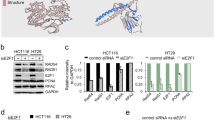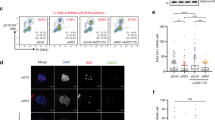Abstract
The RAD 51 protein, a eukaryotic homologue of Escherichia coli RecA, plays a significant role in both mitotic and meiotic homologous recombination. Here, we demonstrate that short-term silencing of the Rad51 gene by specific small interfering RNA (siRNA) that inhibits cell proliferation and reduces the viability of most cells. Cells with suppressed expression of Rad51 gene have altered cell cycles and accumulate in the S and G2 phases. Our findings show that the disruption of homologous recombination leads to cell death. However, some cells, e.g., MCF-7 cells, are insensitive to the suppression of Rad51 gene expression.
Similar content being viewed by others
Abbreviations
- siRNA:
-
small interfering RNA
- antiRAD51-siRNA:
-
small interfering RNA that suppress Rad51 gene expression
- IFA:
-
immunofluorescence assay
- HSF:
-
human skin fibroblasts
- HELF:
-
human embryonic lung fibroblasts
References
Biard, D., Untangling the Relationships between DNA Repair Pathways by Silencing More than 20 DNA Repair Genes in Human Stable Clones, Nucleic Acids Res., 2007, vol. 35, pp. 3535–3550.
Cox, M., Goodman, M., Kreuzer, K., Sherratt, D., Sandler, S., and Marians, K., The Importance of Repairing Stalled Replication Forks, Nature, 2000, vol. 2, pp. 37–41.
Johnson, R. and Jasin, M., Double-strand-break-induced Homologous Recombination in Mammalian Cells, Biochem. Soc. Trans., 2001, vol. 29, pp. 196–201.
Kanaar, R., Hoeijmakers, J., and van Gent, D., Molecular Mechanisms of DNA Double Strand Break Repair, Trends Cell Biol., 1998, vol. 8, pp. 483–489.
Liang, F., Han, M., Romanienko, P., and Jasin, M., Homology-directed Repair Is a Major Double-strand Break Repair Pathway in Mammalian Cells, Proc. Natl. Acad. Sci. USA., 1998, vol. 95, pp. 5172–5177.
Lim, D. and Hasty, P., A Mutation in Mouse RAD51 Results in an Early Embryonic Lethal that Is Suppressed by a Mutation in p53, Mol. Cell. Biol., 1996, vol. 16, pp. 7133–7143.
McGlynn, P. and Lloyd, R., Recombinational Repair and Restart of Damaged Replication Forks, Nat. Rev. Mol. Cell Biol., 2002, vol. 3, pp. 859–870.
Mladenov E., Tsaneva, I., and Anachkova, B., Cell Cycledependent Association of Rad51 with the Nuclear Matrix DNA, Cell Biol., 2007, vol. 26, pp. 36–43.
Pierce, A., Stark, J., Araujo, F., Moynahan, M., Berwick, M., and Jasin, M., Double-strand Breaks and Tumorigenesis, Trends Cell Biol., 2001, vol. 11, pp. 52–59.
Pittman, D. and Schimenti, J., Midgestation Lethality in Mice Deficient for the RecA-related Gene, Rad51d/Rad51l3, Genesis, 2000, vol. 26, pp. 167–173.
Raderschall, E., Stout, K., Freier, S., Suckow, V., Schweiger, S., and Haaf, T., Elevated Levels of Rad51 Recombination Protein in Tumor Cells, Cancer Res., 2002, vol. 62, pp. 219–225.
Schwartz, M., Zlotorynski, E., Goldberg, M., Ozeri, E., Rahat, A., le Sage, C., Chen, B., Chen, D., Agami, R., and Kerem, B., Homologous Recombination and Nonhomologous End-joining Repair Pathways Regulate Fragile Site Stability, Genes Dev., 2005, vol. 19, pp. 2715–2726.
Slupianek, A., Schmutte, C., Tombline, G., Nieborowska-Skorska, M., Hoser, G., Nowicki, M., Pierce, A., Fishel, R., and Skorski, BCR/ABL Regulates Mammalian RecA Homologs, Resulting in Drug Resistance, Mol. Cell, 2001, vol. 8, pp. 795–806.
Takata, M., Sasaki, M., Sonoda, E., Morrison, C., Hashimoto, M., Utsumi, H., Yamaguchi-Iwai, Y., Shinohara, A., and Takeda, S., Homologous Recombination and Non-homologous End-joining Pathways of DNA Double-strand Break Repair Have Overlapping Roles in the Maintenance of Chromosomal Integrity in Vertebrate Cells, EMBO J., 1998, vol. 17, pp. 5497–5508.
Takata, M., Sasaki, M., Tachiiri, S., Fukushima, T., Sonoda, E., Schild, D., Thompson, L., and Takeda, S., Chromosome Instability and Defective Recombinational Repair in Knockout Mutants of the Five Rad51 Paralogs, Mol. Cell Biol., 2001, vol. 21, pp. 2858–2866.
Tashiro, S., Kotomura, N., Shinohara, A., Tanaka, K., Ueda, K., and Kamada, N., S-phase Specific Formation of the Human Rad51 Protein Nuclear Foci in Lymphocytes, Oncogene, 1996, vol. 12, pp. 2165–2170.
Thompson, L. and Schild, D., Recombinational DNA Repair and Human Disease, Mutat. Res., 2002, vol. 509, pp. 49–78.
Tsuzuki, T., Fujii, Y., Sakumi, K., Tominaga, Y., Nakao, K., Sekiguchi, M., Matsushiro, A., Yoshimura Y., and Morita, T, Targeted Disruption of the Rad51 Gene Leads to Lethality in Embryonic Mice, Proc. Natl. Acad. Sci. USA, 1996, vol. 93, pp. 6236–6240.
Weaver, D., What to Do at an End: DNA Double-strand Break Repair, Trends Genet., 1995, vol. 11, pp. 388–392.
Xia, S., Shamans, M., and Shmookler, Reis, R., Elevated Recombination in Immortal Cells Is Mediated by HsRad51 Recombinase, Mol. Cell. Biol., 1997, vol. 17, pp. 7151–7158.
Author information
Authors and Affiliations
Corresponding author
Additional information
Original Russian Text © T.A. Shtam, E.Yu. Varfolomeeva, E.V. Semenova, M.V. Filatov, 2008, published in Tsitologiya, Vol. 50, No. 5, 2008.
Rights and permissions
About this article
Cite this article
Shtam, T.A., Varfolomeeva, E.Y., Semenova, E.V. et al. Role of human RAD51 recombinase in the cycle checkpoint and survival of a cell. Cell Tiss. Biol. 2, 463–467 (2008). https://doi.org/10.1134/S1990519X08050027
Received:
Published:
Issue Date:
DOI: https://doi.org/10.1134/S1990519X08050027




